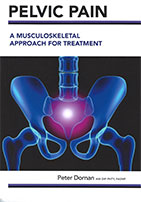Pudendal Neuralgia
Treatment by mobilsation and exercises - A Musculoskeletal Approach
1. IntroductionUrologists and gynaecologists regularly have patients presenting with symptoms of pudendal neuralgia (PN). PN is a recognised cause of chronic pelvic pain in the regions served by the pudendal nerve, typically presenting as pain in the penis, scrotum, labia, perineum, or anorectal region. Other symptoms may include dysuria (pain during voiding) urge incontinence and pain during or after ejaculation. There may be corresponding sexual and erectile dysfunction problems including impotence, impacting on relationships. |
Of particular interest, one perineal branch of the nerve, the inferior pudendal (long scrotal nerve) curves below and in front of the ischial tuberosity, pierces the fascia lata and runs to the skin of the scrotum in the male and the labium majus in the female, scrotal pain (and labia pain) being one of the consistent symptoms of this condition. As several of the lumbar nerves, in particular, the posterior femoral cutaneous nerve, inferior gluteal nerve, the tibial (medial popliteal) nerve, the common peroneal (lateral popliteal) nerve and the perforating cutaneous nerve, derive at least one slip from S2,S3 or S4, the patient may also complain of pain in the lower back, groin, buttocks, posterior thigh, calf or ankle. This may be referred either by neural convergence, by direct injury to the lumbar area, or by chronic SIJ damage impacting on L5S1, thereby interfering with local emitting lumbar nerves. Given the wide range of enervation of the SIJ and its adjacent neural structures, SIJ capsular stimulation may refer various pain patterns to the buttock, groin, thigh, calf or foot. 2. TreatmentThe first aim of rehabilitation is to mobilize the SIJ. This is attempted by exercises and manual (manipulative) techniques. Secondly, the aim is to regain motor-control of the muscles controlling the joint with exercises. Before exercises, heat is applied to patient’s lower back (SWD, very mildly thermal, 10 minutes). The final phase of treatment is to be absolutely critical of posture, particularly in sitting. The aim is to maintain the correct lumbar curve, often creating the need to prescribe the use of a lumbar roll.
3. New Study
Peter has just completed a four year post graduate study at the University of Queensland with colleague Michel Coppieters to validate these findings.
ConclusionThis case series provided Level 3 evidence that a program of motor control exercises and mobilization for the lumbar-pelvic region in patients with symptoms of pudendal neuralgia was successful in producing improvement in 95.5% of participants. Over a three month follow-up period, 39% had a recurrence of symptoms, but these could be managed by a home exercise program. 47.8% of the participants had also complained of sexual difficulties. Of these, after a three month follow-up period, 63.5% reported to be symptom free. Peter’s research and clinical experience after treating 6000 patients has culminated in him writing a book Pelvic Pain – A musculoskeletal approach for treatment
The following manipulative procedures should only be carried out by a qualified health professional with appropriate training. Toowong Rehabilitation Centre Pty. Ltd (also known as Peter Dornan Physiotherapy) does not accept any responsibility for any action taken by the user, nor any liability for any injury, loss or damage incurred by use or reliance on the information contained herein. Further, Toowong Rehabilitation Centre Pty Ltd (Peter Dornan Physiotherapy) makes no warranties of any kind, either expressed or inferred, and in no event will they be liable for damages whatsoever. |
« go back to overview
